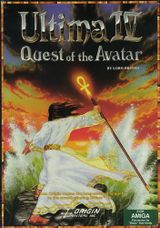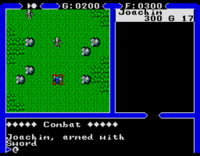Ultima IV: Quest of the Avatar
This article is about the game Ultima IV. For other uses, see Quest of the Avatar (disambiguation).
Ultima IV: Quest of the Avatar is the fourth game in the series and the first installment of the “Age of Enlightenment” trilogy. It was published and released in 1985 by Origin for the Apple II, C64, IBM PC and Atari 8-bit. Ports for the Amiga and Atari ST with some enhanced graphics followed 1988, for the NES and Sega Master System (SMS) ports were released in 1990.
Gameplay[edit]
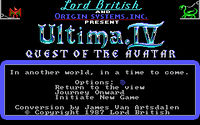
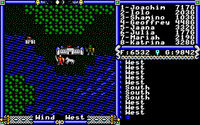
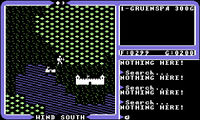
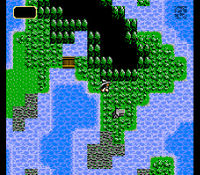
The game became much more complex and deep with this installment, compared to Ultima III. The people of Britannia can talk interactively. The puzzles are more complex, and more information has to be gathered to solve the game. Cities, castles and dungeons are much more detailed, as is the wilderness. The number of items to be found has risen, and the total party size is expanded to eight.
The most significant improvement for the game's creator is the plot, where the player has to follow a path of Virtue to win. The killing and thievery of the three earlier games is now strongly discouraged. Instead, the player must prove to be a "good guy." The whole system of virtues in this game changes the RPG experience.
The Story[edit]
Spoiler warning: Plot and/or ending details follow.
With the end of the Triad of Evil and, therefore the Ages of Darkness, a new age has begun for Sosaria, which now is Britannia – the "Age of Enlightenment". In the now united kingdom, the people search for spiritual enlightenment now that they are enjoying an age of prosperity.[1] However, there is one thing still missing: a role-model to be an example of the Eight Virtues. The people need this paragon of virtue called the Avatar.
The player again plays the Stranger, but this time the ultimate goal is not to defeat an evil villain – instead a path of Virtue has to be followed and a virtuous life led. Together with seven companions, the Stranger manages to master all of the eight Virtues by talking to the people, meditating at shrines and setting a good example by living the Virtues. Recovering a number of important artifacts, as well as the Key of Three Parts, the party then descends into the depths of the Abyss, where they ultimately recover the Codex of Ultimate Wisdom. The Codex asks a series of questions relating to the Virtues, after which it confirms the Stranger as the Avatar, the hero of Britannia and defender of Virtue.
Spoilers end here.
Development[edit]
Part of the reason for the change in direction in the series in this installment were letters from concerned parents and other parties, whom Richard Garriott felt misunderstood the games.[2] Bothered About Dungeons and Dragons was one such organization. This made Garriott consider the impact that the games have on the players, and therefore sought a more edifying theme;[3] therefore, the Virtues.
Differences Between Platforms[edit]
- Main article: Computer ports of Ultima IV
There are quite a number of ports of Ultima IV that are significantly different from each other. The original version was the one for the Apple II, from which all others were ported.
The 8-bit ports for the Apple II, C64 and Atari were similar in terms of graphics and music, and indeed shared much of the program code, as all these systems were based on the MOS 6502 CPU or derivatives thereof. The Atari 8-bit lacked music and had fewer colors, and on PAL Ataris it was black-and-white; the Apple II version offered more voices of music than the C64 version, but a sound card (Mockingboard or compatible) was required for music, as the Apple II's built-in sound capabilities were limited to simple effects. The C64 version had only black-and-white graphics in the 3D dungeon view.
The 16 bit-ports for the PC, Atari ST and Amiga were quite different. While the overworld graphics looked the same, the introduction sequence and dungeons looked better on the Amiga and Atari ST. Also, the PC lacked the mouse support and musical score of these ports.
The NES-port has many of the same changes as the port of Ultima III, but uses the graphical style more commonly found in Japanese games. The port for the Sega Master System, on the other hand, is surprisingly accurate and has the traditional graphics and sound, with obvious limitations only on conversations. For both ports see Console ports of Ultima IV.
Translations[edit]
Ultima IV had the dubious honor of being one of the first Ultima games translated into French, with both manuals and in-game text fully translated. While the translation for the manual was decent (albeit with some obvious mistakes), the in-game translation appears to have been done by people with no understanding of French.
An example of the mistakes in the translation is the translation of the traditional "Board Frigate" message seen when boarding a boat. It was translated as "Tableau Frégate", which translates "Board" as a noun, not a verb.
The French version contains a very severe bug which prevents the use of any item – since items to be used are supposed to typed, and the game recognizes neither the French nor the English spelling. As such, it is extremely difficult to become an 8-part Avatar since the player cannot use the Silver Horn to get to the Shrine of Humility, and impossible to complete the game since the player cannot use the Virtue Stones on the altars to get the Three Part Key, or the required items to open the Abyss.
See also Translations of Ultima games.
Release[edit]
Ultima IV was a sensation in 1985. Because of its unique story, it sold very well and inspired many other developers. It was the top-rated Adventure/Action computer game in 1986.[4]
The game was included in several compilations:
- Ultima Value Pak (1990) in its original game box.
- Ultima Trilogy IV V VI (1992)
- Ultima I-VI Series (1993)
- Ultima Collection (1998)
In Japan, the game got included in the compilation Ultima Complete.
Distribution of the game in Europe was done by MicroProse.
Included with the Game[edit]
The release of Ultima IV included these item with the game:
- The book The History of Britannia.
- The book The Book of Mystic Wisdom.
- The Player Reference Card.
- A cloth map of Britannia in Ultima IV.
- An ankh amulet.
The Taiwanese Edition published by JingHsun Co. included an Ankh Key Ring.
Availability[edit]
Ultima IV for the PC along with all documentation can be freely downloaded from http://www.ultimaforever.com/.
Upgrades[edit]
Bug Patches[edit]
The versions for MOS-6502-based 8-bit systems (Apple II, Commodore, Atari 8-bit) suffer from a bug where the player always gets the same message when meditating in the Shrines, no matter how many cycles meditated. This does not make the game unwinnable, but removes some important information. Patches exist at least for Apple and Commodore.
Some versions of the game have a problem in the Hythloth dungeon on level 6 (making it impossible to progress through that dungeon without using teleportation magic). A fan patched hythloth.dng file for the PC version is available. An alternative version of the Hythloth patch can be found at moddb.com.
MS-DOS Upgrade Patch[edit]
The fan-made Ultima IV Upgrade Patch for the IBM PC version, running MS-DOS lifts the graphics to 256 color VGA, and also adds the missing music, a frame limiter, hotkeys and several other fixes and extras.
Commodore 64 Upgrade Patch[edit]
Ultima IV Gold is a patched version of Ultima IV for the Commodore 64 which fixes numerous bugs and introduces a number of speed optimizations and user interface enhancements.
Ultima IV Remastered is the further refinement of the previous patch, sporting many more enhancements.
Solo Patch[edit]
The fan-made Solo Patch for the IBM PC version allows the game to be completed either solo, or with any number of companions. The original game must be completed with 8 party members, to show the Avatar's leadership.
Dragon Mod[edit]
The fan-made “Dragon Mod” for the MS-DOS version allows the player to acquire a ride-able dragon. The mod may be the first to add new content to the game. The mod actually modifies the executable to add the functionality of the dragon.
Xu4[edit]
There has also been a fan effort to create a platform-independent port of Ultima IV called xu4. Xu4 is a nearly complete and extremely accurate port of the original Ultima IV. Advantages include greater compatibility with modern operating systems (the PC speaker sound effects of the DOS version work poorly or not at all in Windows, depending on the Windows version; also the DOS version is of course completely incompatible with 64-bit Windows) and an array of options to either improve the gaming experience or help retain the original feel of the DOS version. Xu4 itself is an open source project, but it requires the data files from the PC version of Ultima IV to operate, which are obviously not open source.
Remakes[edit]
There are also a couple of Ultima IV remakes; the most notable ones are two mods for the game Neverwinter Nights. They are Avatarship and Ultima IV Reborn.
Macro Scripts[edit]
Using macros can help ease some of the repetitive tasks in Ultima IV.
More Game Related Information[edit]
- NPCs
- Spell list
- Bugs
- Cheating in Ultima IV
- Ultima IV transcript
- Ultima IV walkthrough
- Ultima IV Real-life references and Easter eggs
- Monster data
- Virtues in Ultima IV
- Ultima IV internal formats
- Ultimatrix – map viewer
- Ultima Saved Game Editor
- For how the character creation works, see Character creation
Trivia[edit]
- A completion certificate could originally be obtained after winning the game.
- Richard Garriott himself sees it as the best part of the series, a little before Ultima VII.
- In early Apple versions, if answering the final questions in the Abyss incorrectly even once, the player is ejected back to the surface.[5]
- For the first ten thousand moves, only four types of monsters spawn, for the second ten thousand only eight, and after that the game "breaks loose."[6]
- An early concept for Ultima IV involved going to the planes of hell which "will require a completely different style of graphics from anything he has used in the past."[7]
- One rumor that turned out to be entirely baseless was the Golden Trumpet. See the article in question for more details.
Gallery[edit]
Cover of the Japanese FM Towns version
External Links[edit]
- Ultima IV at Notable Ultima
- Graphics upgrade and music patch for Ultima IV
- xu4 – Windows upgrade for Ultima IV
- Nitpicks for Ultima IV
- Ultima IV at Ultima Aiera
- Fully Annotated Large Map of Britannia (SPOILER)
- Clickable Large Map of Britannia (SPOILER)
- Ultima IV on Wikipedia
- Ultima IV – Quest of the Avatar at C64 Wiki
References[edit]
- ↑ The History of Britannia (in-game). Page 20.
- ↑ Addams, Shay. "More than 'Just Beating Up Monsters'". The Official Book of Ultima. COMPUTE! Publications, Inc.: 1990. Page 35.
- ↑ Addams, Shay. "The Turning Point". The Official Book of Ultima. COMPUTE! Publications, Inc.: 1990. Page 37-38.
- ↑ Computer Gaming World, Number 27. April 1986. Page 48.
- ↑ Computer Gaming World 25 (1986): 14
- ↑ Computer Gaming World 26 (1986): 20
- ↑ Softline v3n1
